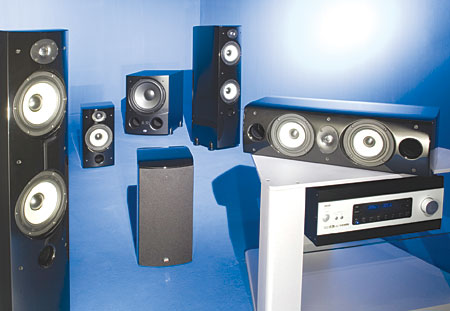PSB G-Design Speaker System and Adcom GFR-700HD A/V Receiver
Paul Barton doesn't merely talk about Canada's National Research Council; he preaches about the facility, acting as the Billy Graham for Canadian scientific research. And well he should. The NRC was founded to provide scientific, practical, and developmental support to Canadian companies wishing to compete in a global economy. Barton began using the NRC's facilities and its scientific minds in 1974, just two short years after he launched a modest little speaker company called PSB. Within a year, PSB released the Avante, the first speaker the company designed with the NRC's help. Since then, Barton has continued to design well-received and well-reviewed speakers, each delivered with assistance from the NRC facilities.

During an interview as part of this review of the G-Design speaker array, Barton waxed poetic (really!) about the NRC's benefits to product development across Canada for assorted businesses, including his business, speakers. You get the feeling that here sits an engineer and violinist who loves the process of creation, one who cannot contain the excitement he experiences running computer optimizations/simulations on his next vision in the NRC's world-class anechoic chamber. For example, Barton will typically change out a small part in a speaker under development and conduct a test, analyze the numbers carefully, adjust some more, then run another simulation, and so on and so on. "Seventy-eight," he offers. "I've conducted 78 optimizations thus far, developing our new high-end line, whose working title is Synchrony. We worked just as thoroughly with optimizations with the G-Design Series."
Golly G
The G-Design constitutes a bass-reflex, front-ported design with cabinets dressed in a stunning high-gloss black finish. (The center channel has a port flanking each woofer.) In addition, the tweeters across the entire G-Design family are 1-inch aluminum Ferrofluid-cooled domes, the center channel uses a pair of 5.25-inch woven fiberglass cones that flank the tweeter, and the front and surround speakers rely on identical 6.5-inch Seas sourced (and adapted) woofers, utilizing cast-baskets and rubber surrounds. "The drivers," offers Barton, "are direct trickle-down descendants from our high-end Platinum series. Only the colors are different between the two lines." This design showcased what could emanate from the mind of a genius, as he has been called, when parts cost is not a primary part of the equation.
Barton further points out that the G-Design series also relied on science to determine the internal bracing points. Thanks to the use of the NRC's laser vibrometer, PSB located the precise bracing points to minimize vibrations in each of the array's cabinets, a sophisticated design, indeed. Add to that PSB's use of "blind listening" panels to refine the speakers even more, and you'll understand why the company has won so many awards.
To create a 5.1-channel sys-
tem for this review, I used PSB's SubSeries 6i subwoofer with the GT1 towers, GC1 center, and GB1 surrounds. Moving away from current trends to build ever-smaller subwoofers, the 6i design sports a 12-inch polypropylene driver in a dual-ported reflex design. Using a 225-watt Class H, discrete MOSFET amplifier, the sub, according to the manufacturer, hits dynamic peaks of up to 700 watts. The sub has line- and speaker-level inputs, as well as a crossover bypass. Although it's not an official part of the G-Design Series family, the SubSeries 6i proves itself to be a good match for this system.
Amped Up
With a massive toroidal transformer, the Adcom GFR-700HD receiver is rated at 145 watts per channel into five channels. (You have the option of connecting two additional channels of line outputs into another amplifier for a 7.1-channel configuration.) With flexible bass management and options for SACD and DVD-Audio playback, the GFR-700HD meets most basic home theater needs and then some, including tape monitor output.
First and foremost, the Adcom connects to display devices with composite, S-video, component/
progressive-scan video, and HDMI (one output and two inputs). Additionally, the receiver allows you to connect your legacy video sources (via composite, S-video, and component video), and it upconverts standard NTSC/PAL signals to match your display's native resolution capability, up to 1080p. To activate the receiver's video-scaling option, you need to set the output of a progressive-scan DVD player to 480i. It's worth noting that any 480p and high-def analog source you send through the component video inputs will reach the component output at its native resolution.
The video processor's basic controls allow you to adjust the contrast, brightness, color, tint, ACE (adaptive color enhancement options: high, medium, low, and a default off), plus edge enhancement. The advanced options include seven noise-reduction filters, eight deinterlacing modes, and a film mode that has an auto-detect or off function.
The receiver processes DTS Neo:6, DTS ES, Dolby Pro Logic IIx, and Dolby Digital EX. Moreover, a wealth of options lets you configure your speakers, including, for the tweakier of us, crossover control (40, 60, 80, 100, 120, and 150 hertz) for the front, center, and surround speakers. Auto calibration, however, is not part of the Adcom's package. To set delays and the like, you must first measure the distance from each speaker to the listening position, enter it, and press "Select." Following this process, the GFR-700HD automatically configures the delay. The GFR-700HD also lets you balance channels. (Adcom recommends using an SPL meter for precise measurement and adjustment.) What's nice is that you can adjust each channel's trim on the fly, depending on your needs.






























































